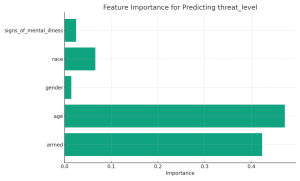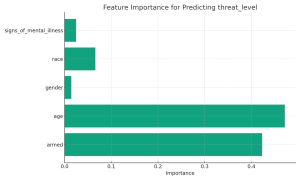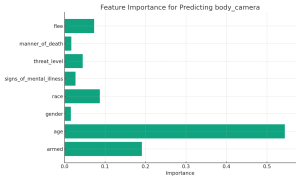Introduction
The dataset provides information on fatal police shootings in the US. This report outlines the results of three machine learning classification tasks performed on the dataset: predicting the manner of death, predicting the perceived threat level, and predicting whether a body camera was active during the incident.
Task 1: Predict manner_of_death
Features used: armed, age, race, threat_level, and signs_of_mental_illness.
Accuracy: 0.94
Classification Report:
precision recall f1-score support
0 0.95 0.99 0.97 1171
1 0.08 0.02 0.03 60
Feature Importance

Task 2: Predict threat_level
Features used: armed, age, gender, race, and signs_of_mental_illness.
Accuracy: 0.66
Classification Report:
precision recall f1-score support
0 0.71 0.83 0.76 772
1 0.54 0.38 0.45 418
2 0.42 0.25 0.31 40
Feature Importance:

Task 3: Predict body_camera
Features used: armed, age, gender, race, threat_level, manner_of_death, and flee.
Accuracy: 0.80
Classification Report:
precision recall f1-score support
False 0.86 0.92 0.89 961
True 0.14 0.08 0.10 160
Feature Importance:

Insights
- Age consistently appears as a significant factor across all tasks. This suggests that the age of the individual involved plays a crucial role in various aspects of police encounters.
2. The perceived threat level is influential in both predicting the manner_of_death and whether a body_camera was active. This highlights the importance of the perceived threat in police encounters.
3. Armed status also has a notable influence across all tasks, emphasizing the role weapons play in these situations.
4. Features like race, while not the most influential, still play a notable role in certain tasks. This may hint towards societal or systemic factors at play.
5. The use of a body camera appears to be influenced by various factors, including the perceived threat, age, and race. This suggests that the decision to activate a body camera (or the scenarios where it’s active) may not be entirely random.